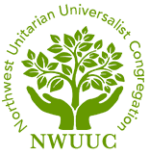The Our Whole Lives Comprehensive Sexuality Education courses mean a lot to me. I’ve taken 7th-9th grade and Young Adult OWL. I’ve facilitated Kindergarten-2nd grade OWL, Middle School OWL, and Adult OWL. It’s an important part of my connection to Unitarian Universalism, not just in terms of lifestyle or politics, but theologically as well. Laura Horton-Ludwig wrote a piece called “Vessels of Divine Love for Each Other” that describes its theological importance. She writes:
“Union is not a myth or a pipe dream, the mystics say: it is our true nature. Buddhists speak of interbeing, the connectedness of all that is. Our Unitarian Universalist tradition gives us the beautiful language of the interconnected web of all existence, of which we are a part. Most of the time we feel separate, but connected is what we are: to others, to the whole of creation, to the energies moving in all things.”
“…We feel separate, but connected is what we are…” And nowhere in the human experience is that more true than in sexuality. Of all the aspects of life that have become commoditized and exploited under capitalism, sexuality may be the most tragic. One of the ways that the consistent media bombardment with unrealistic sexual images hurts us on a spiritual level is that it harms how we see ourselves in comparison. But a component of each of the OWL courses, is that they show participants realistic drawings of people’s bodies, usually including naked bodies of individuals and couples. The drawings are of people of many different ages, body types, and sexualities. The first time I saw these drawings I was pretty uncomfortable, and I earned a stern lecture from the facilitators by cracking jokes to my friends. But over the years, I have found myself remembering some of those pictures at times when I have questioned my own worth and dignity. They have reminded me that each of us is beautiful and deserving of respect, myself included.
I have seen students, literally, from ages 7 to 70, react with discomfort and misbehavior when presented with affirmational messages about each person’s sexuality. But usually, those same students will go home and process that information in their own way, and it’s not uncommon to hear a question or a statement weeks later that shows a high degree of thoughtfulness and acceptance. When we as a congregation weave those patterns into our lives and into our community, we are truly honoring the divine source of interconnectedness that holds us all. The word that comes closest to being able to describe this divine connection is love. Horton writes:
“The mystics tell us, this love, this energy, is always with us, but it’s so powerful that we cannot handle being fully aware of it all the time; it’s too much, it’s too overwhelming—and yet we can receive it filtered through another person. So we can become vessels of divine love for each other, not just with our hearts but with these bodies. That’s why our sexuality is so profoundly connected to our spiritual life: it helps us to feel our longing for connection and love and union, and, if only for a moment, to know the reality that connection and love and union are what we are, not just what we long for.”
May it be so, and may we be the ones to make it so.
Delivered at Northwest Unitarian Universalist Congregation
February 10, 2019
© Rev. Jonathan Rogers

